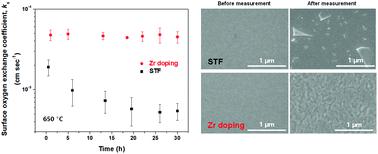当前位置:
X-MOL 学术
›
J. Mater. Chem. A
›
论文详情
Our official English website, www.x-mol.net, welcomes your
feedback! (Note: you will need to create a separate account there.)
Isovalent doping: a new strategy to suppress surface Sr segregation of the perovskite O2-electrode for solid oxide fuel cells
Journal of Materials Chemistry A ( IF 10.7 ) Pub Date : 2020-06-25 , DOI: 10.1039/d0ta02870c Bonjae Koo 1, 2, 3, 4 , Jongsu Seo 1, 2, 3, 4 , Jun Kyu Kim 1, 2, 3, 4 , WooChul Jung 1, 2, 3, 4
Journal of Materials Chemistry A ( IF 10.7 ) Pub Date : 2020-06-25 , DOI: 10.1039/d0ta02870c Bonjae Koo 1, 2, 3, 4 , Jongsu Seo 1, 2, 3, 4 , Jun Kyu Kim 1, 2, 3, 4 , WooChul Jung 1, 2, 3, 4
Affiliation

|
Surface Sr segregation and phase separation are the key reasons behind the chemical instability of Sr-containing perovskite oxide surfaces and the corresponding performance degradation of solid oxide fuel cell O2-electrodes, but to date, practical solutions to prevent this phenomenon are limited. Here, we investigate how isovalent doping (in this case, Zr substitution of Ti) changes the surface morphology, chemical composition, and thus the O2 activation kinetics under actual operating conditions. Thin films of SrTi0.5Fe0.5O3−δ as a representative model perovskite O2-electrode, with Zr doping, are fabricated via pulsed laser deposition and their surface oxygen exchange rates are then characterized via electrical conductivity relaxation assessments. Zr dopants strengthen the Sr–O bonds in the oxide lattice, inhibiting the formation of surface SrOx clusters and significantly reducing the deterioration of the oxygen exchange rates compared to the results from undoped film at 650 °C for 30 h. These observations suggest a new strategy for ensuring the surface stability of Sr-containing perovskite oxides for fuel cell O2-electrodes.
中文翻译:

等价掺杂:抑制固体氧化物燃料电池钙钛矿O2电极表面Sr偏析的新策略
表面Sr的偏析和相分离是含Sr钙钛矿氧化物表面化学不稳定性和固体氧化物燃料电池O 2电极相应性能下降背后的关键原因,但是迄今为止,防止这种现象的实际解决方案受到限制。在这里,我们研究了等价掺杂(在这种情况下为Ti的Zr取代)如何在实际操作条件下改变表面形态,化学成分以及O 2活化动力学。掺杂Zr的SrTi 0.5 Fe 0.5 O 3− δ代表钙钛矿型O 2电极的薄膜制备。然后通过电导率弛豫评估来表征脉冲激光沉积及其表面氧交换速率。与未掺杂薄膜在650°C下30 h的结果相比,Zr掺杂剂增强了氧化物晶格中的Sr-O键,抑制了表面SrO x簇的形成,并显着降低了氧交换速率的降低。这些观察结果提出了确保用于燃料电池O 2电极的含Sr的钙钛矿氧化物的表面稳定性的新策略。
更新日期:2020-07-14
中文翻译:

等价掺杂:抑制固体氧化物燃料电池钙钛矿O2电极表面Sr偏析的新策略
表面Sr的偏析和相分离是含Sr钙钛矿氧化物表面化学不稳定性和固体氧化物燃料电池O 2电极相应性能下降背后的关键原因,但是迄今为止,防止这种现象的实际解决方案受到限制。在这里,我们研究了等价掺杂(在这种情况下为Ti的Zr取代)如何在实际操作条件下改变表面形态,化学成分以及O 2活化动力学。掺杂Zr的SrTi 0.5 Fe 0.5 O 3− δ代表钙钛矿型O 2电极的薄膜制备。然后通过电导率弛豫评估来表征脉冲激光沉积及其表面氧交换速率。与未掺杂薄膜在650°C下30 h的结果相比,Zr掺杂剂增强了氧化物晶格中的Sr-O键,抑制了表面SrO x簇的形成,并显着降低了氧交换速率的降低。这些观察结果提出了确保用于燃料电池O 2电极的含Sr的钙钛矿氧化物的表面稳定性的新策略。











































 京公网安备 11010802027423号
京公网安备 11010802027423号